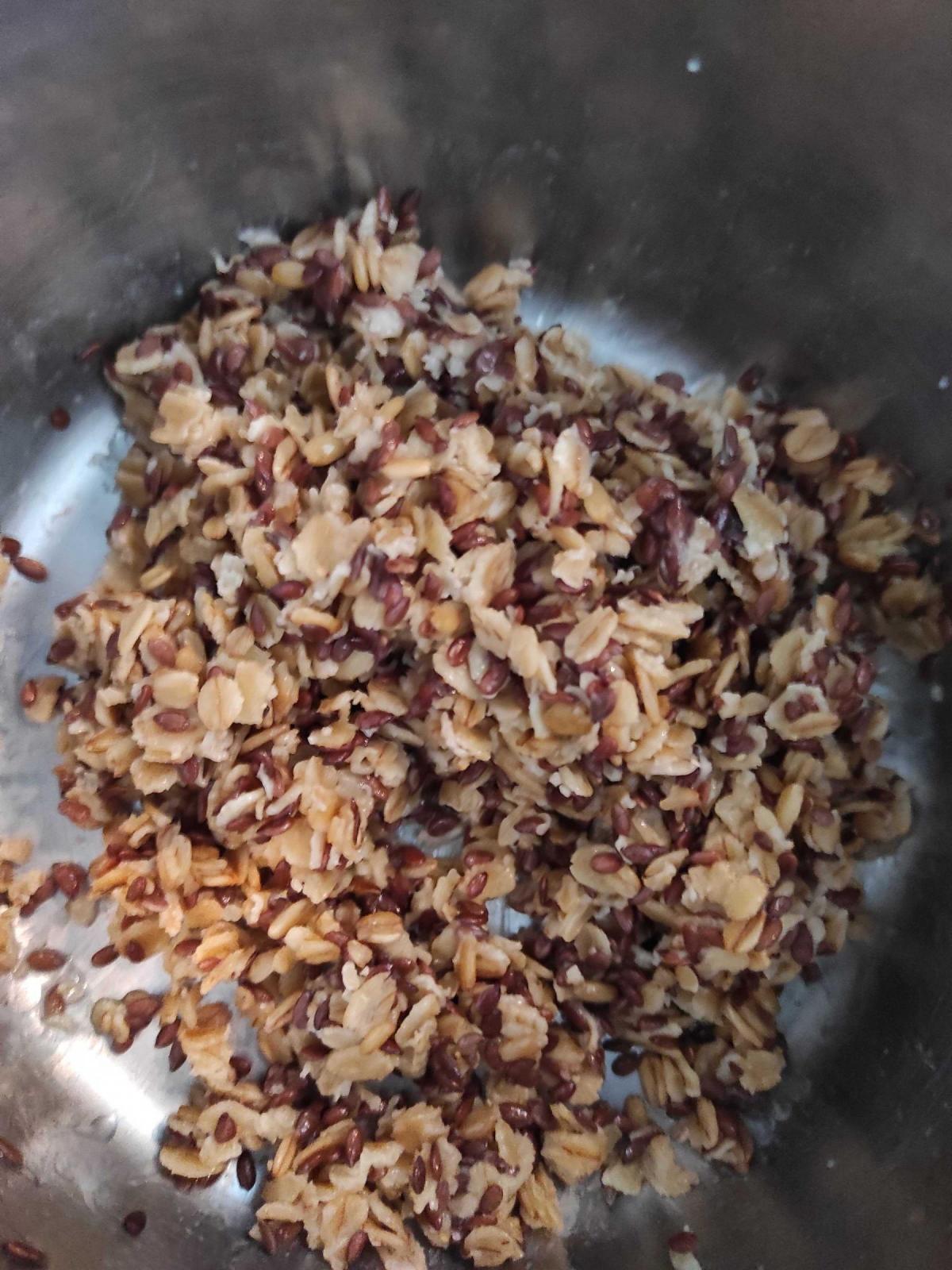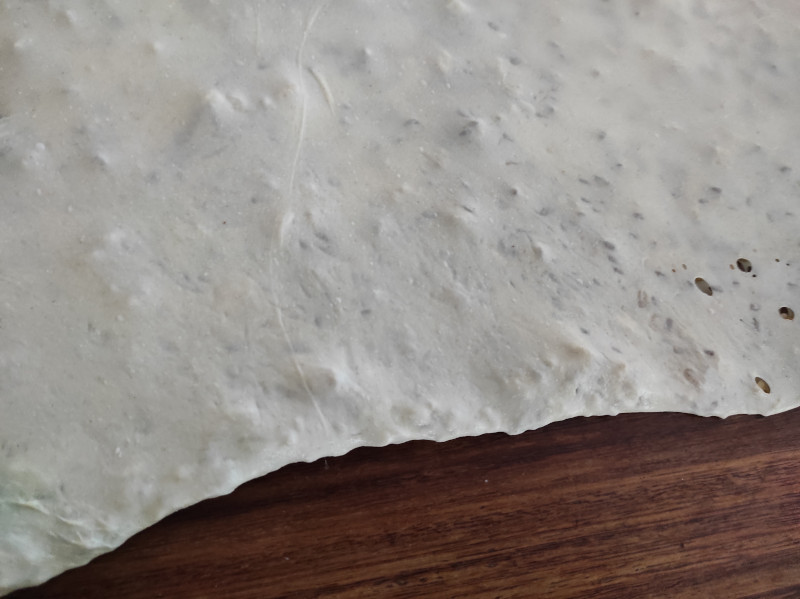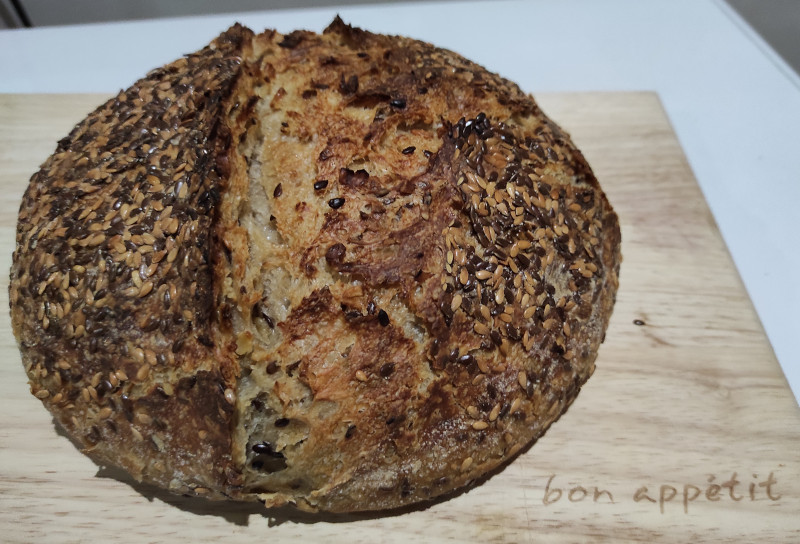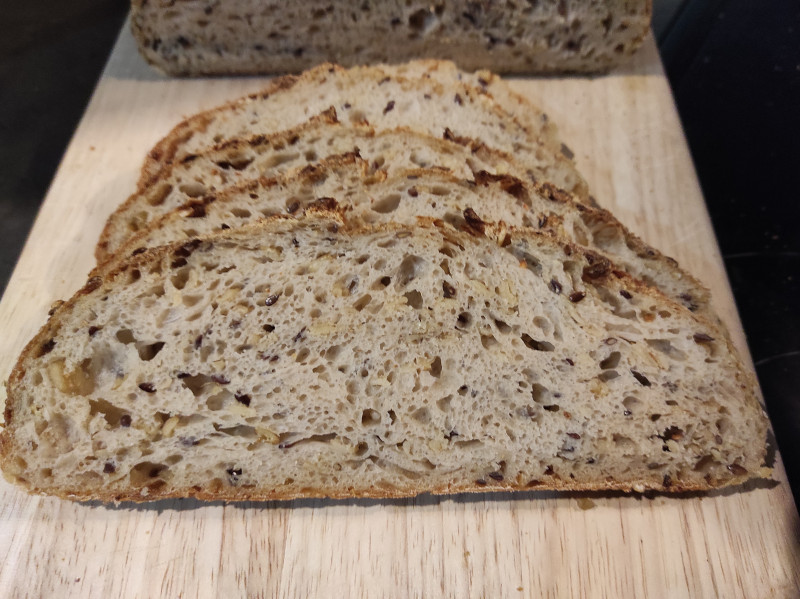
Oat and flax soaker bread


Oat porridge breads are a bit of an enigma for me really. Sometimes, I get glimmers of that fabled custard consistency and the promise of an extra special bread. And the smell of that oat topping while baking is unsurpassed. Other times, the addition of the oats just exceeds the hydration capacity of my flours. And, even worse there is that dreaded gummy layer you get at the base of the bread if you don't bake it extra long.
"Sourlotti by Abby" has quite a clever recipe and YouTube video with an oat and flax soaker. The nice thing about the soaker is that it uses a fair amount of butter (more than I would use if I was making oat porridge for myself!) and doesn't contain a lot of water. Plus it has flax/linseed in it!
I did tweak the recipe to make it my own, reduced the hydration to 74% and gave it a longer bake than I normally do. And I used a blend of white bread flours - the ridiculously high gluten sifted hard white mixed with a lower protein supermaket flour (to give the crust and reduce that springy gluten mouth feel). Made a lovely loaf, and this is an interesting new way to make an oat bread! I think I could have given it a little longer to ferment, but I'm so nervous with oat porridge breads having experienced what can go wrong.

Method: 1 hour autolyse. Then mixed in stand mixer for 8 minutes with liquid and pourable levain (fed the night before 1:10:10 with bread flour and 11 hours old at the time). Then left uncovered in the mixer for 15 minutes. Added the salt with a 3 minute mix, removed dough from mixer, placed on counter and gave a strong counter fold. Then left covered with the upside down mixer bowl for 15 minutes. Laminated in all of the soaker. Not sure what magic I got write with the mixer, or maybe it is just that I found the appropriate hydration for the flour mix but the gluten was just incredible and I could stretch the dough super thin - see the pic! Dough then placed in the proofer set to 26°C and two sets of coil folds were given. Final shaping was performed 6 hours after adding the levain. The banneton was then placed back in the proofer for an extra hour. At the end of that time there was a volume increase of 40%. 7 hours to achieve 40% increase is long for my starter at this temp - think perhaps that my levain was a little too past the peak, or I added the salt to soon. Banneton was then placed in coldest fridge shelf for a 19 hour retard. Whilst the oven was warming the banneton was placed in the freezer for 1 hour. Bread was baked at 240°C for 25 minutes in dutch oven covered, followed by 23 minutes at 210°C for a total bake time of 48 minutes - which is longer than my normal 40 minutes.

Never managed to stretch this thin before in lamination!




Comments
If you are not familiar with them, Dan hosted both a 5-grain CB and an oat porridge CB that you might wish to peruse.
It sure does look good, tasty and wholesome.
I have to try the Hamelman 5 grain levain now, it has always felt like a bread that I need to make, thanks so much for the push.... nearly there... just need to somehow get cracked rye!
Jon that looks great and I bet it tastes great. I’ve seen other bakers doing buttered oats and haven’t tried it myself.
Benny
I prepared the oats and flaxseed meal as she described and added it to my usual multigrain loaf near the end of kneading in my KA. I used flaxseed meal for digestibility. The dough was a little stickier than usual. I like the result. The whole oat flakes add a nice touch. I'll brown them more next time.
A nice looking loaf, Gary. Is that a DOS recipe program you're using ;)
Lance
It is a screenshot of my Linux terminal running NeoVim displaying the output of a Python script I wrote to use a linear programming library for creating bread formulas. I describe the relationships among ingredients and the script solves for the final values.
Crazy? Yes! But programming is fun and spreadsheets are not.
Gary
Nice bread, the oats look like they've vanished into the bread.
It ain't a geek thing until you share a link to your (public) git repo....
https://github.com/gbishop/bake
It's a hack but feel free to use any of it for anything.
Great innovation, but I think I will stick to Onenote!
Lance
Gary, nice to see a history of your bakes, interesting to read your comments on what worked for you and what didn't.
In case you're wondering who forked the repo that would be me, although I don't think my brain is special enough to handle pulp!
-Jon
I rewrote the solver to use scipy.optimize.least_squares so it could handle the nonlinear equations that result when I allow grams and baker's percent in the same formula.
I also added a command flag that will convert gram values into baker's percent automagically. Now I can transcribe a recipe given in grams (or any mass unit) and get all the percentages without first working out the total flour.
Good fun learning to use a new tool.
Gary